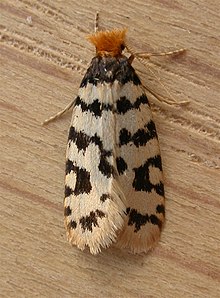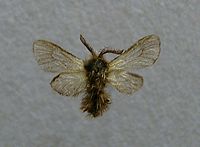Баттерский мотылька
Эта статья требует дополнительных цитат для проверки . ( февраль 2018 г. ) |
| Пактевые мотыльки | |
|---|---|

| |
| Adult of an undescribed Iphierga species from Aranda (Australia) | |

| |
| "Bag" of unidentified species | |
| Scientific classification | |
| Domain: | Eukaryota |
| Kingdom: | Animalia |
| Phylum: | Arthropoda |
| Class: | Insecta |
| Order: | Lepidoptera |
| Superfamily: | Tineoidea |
| Family: | Psychidae Boisduval, 1828 |
| Diversity[1] | |
| 10 subfamilies, 241 genera and 1,350 species | |

Psychidae собой ( мотыльки с мешочком , также просто мешочки или багмоты ) представляют лепидоптера ( семейство бабочки и мотыльки ) . Семейство мешочков довольно мало, с около 1350 видов [ 2 ] описанный Виды мешочков встречаются во всем мире, с некоторыми, такие как Bagworm Snailcase ( Apterona helicoidella ), в современную времени урегулируя континенты, где они не являются местными.
Другое общее название для Psychidae-это « мотыльки », но это так же хорошо используется для тех, кто носит случай (Coleophoridae). Имена относятся к привычкам гусениц этих двух семей, которые строят небольшие защитные случаи, в которых они могут спрятаться. Бэквормы принадлежат к суперсемейству Tineoidea , которая является базальной линией дитрисии ( как и Gelechioidea , в которую входят носители случай). Это означает, что мешочки и носители корпусов так же тесно связаны друг с другом, как и с бабочками (Rhopalocera).
Most bagworms are inoffensive to humans and inconspicuous; some are occasional nuisance pests. However, a few species can become more serious pests, and have caused significant damage e.g. to wattle (Acacia mearnsii) in South Africa and orange (Citrus × sinensis) in Florida. If detected early, picking the cases from the trees while in their pupa stage is an effective way to check an infestation; otherwise, insecticides are used. One bagworm species, the fangalabola (Deborrea malgassa) of Madagascar, is in some places encouraged to breed on wattle trees, because its pupae are collected as a protein-rich food.
Description
[edit]The caterpillar larvae of the Psychidae construct cases out of silk and environmental materials such as sand, soil, lichen, or plant materials. These cases are attached to rocks, trees or fences while resting or during their pupa stage, but are otherwise mobile. The larvae of some species eat lichen, while others prefer green leaves. In many species, the adult females lack wings and are therefore difficult to identify accurately. Case-bearer cases are usually much smaller, flimsier, and consist mainly of silk, while bagworm "bags" resemble caddisfly cases in their outward appearance – a mass of (mainly) plant detritus spun together with silk on the inside.
Bagworm cases range in size from less than 1 cm to 15 cm among some tropical species. Each species makes a case particular to its species, making the case more useful to identify the species than the creature itself. Cases among the more primitive species are flat. More specialized species exhibit a greater variety of case size, shape, and composition, usually narrowing on both ends. The attachment substance used to affix the bag to host plant, or structure, can be very strong, sometimes requiring a great deal of force to remove.[citation needed] Body markings are rare. Adult females of many bagworm species are larviform, with only vestigial wings, legs, and mouthparts. In some species, parthenogenesis is known. The adult males of most species are strong fliers with well-developed wings and feathery antennae but survive only long enough to reproduce due to underdeveloped mouthparts that prevent them from feeding. Most male bagworm wings have few of the scales characteristic of most moths, instead having a thin covering of hairs.
-
"Bag" of Pachythelia villosella (Oiketicinae)
-
Adult specimen of Phalacropterix graslinella (Oiketicinae)
-
Bagworm larva in the Negev (April 2014). Case is made mostly of feathery stork's bill seeds (Erodium cicutarium).
-
Bagworm (possibly Hyalarcta huebneri) extending its forequarters from its case in the act of locomotion.
Ecology
[edit]In the larval stage, bagworms extend their head and thorax from their mobile case to devour the leaves of host plants, often leading to the death of their hosts. Trees infested with bagworms exhibit increasingly damaged foliage as the infestation increases until the leaves are stripped bare.[citation needed] Some bagworms are specialized in their host plants (monophagous), while others can feed on a variety of plant species (polyphagous). A few species also consume small arthropods (such as the camphor scale Pseudaonidia duplex, a scale insect).[citation needed] One bagworm species was found to eat an orb-web of Plebs sachalinensis (Araneae, Araneidae) entirely.[3]
Since bagworm cases are composed of silk and the materials from their habitat, they are naturally camouflaged from predators. Predators include birds and other insects. Birds often eat the egg-laden bodies of female bagworms after they have died. Since the eggs are very hard-shelled, they can pass through the bird's digestive system unharmed, promoting the spread of the species over wide areas.[4]
A bagworm begins to build its case as soon as it hatches. Once the case is built, only adult males ever leave the case, never to return, when they take flight to find a mate. Bagworms add material to the front of the case as they grow, excreting waste materials through the opening in the back of the case. When satiated with leaves, a bagworm caterpillar secures its case and pupates.[citation needed] The adult female, which is wingless, either emerges from the case long enough for breeding or remains in the case while the male extends his abdomen into the female's case to breed.[5] Females lay their eggs in their case and die. The female evergreen bagworm (Thyridopteryx ephemeraeformis) dies without laying eggs, and the larval bagworm offspring emerge from the parent's body. Some bagworm species are parthenogenetic, meaning their eggs develop without male fertilization. Each bagworm generation lives just long enough as adults to mate and reproduce in their annual cycle.[6]
Systematics
[edit]Ten subfamilies[1] and about 240 genera are recognized among the bagworms.
The subfamilies of Psychidae, with some notable genera and species also listed, are:
References
[edit]- ^ Jump up to: a b Nieukerken, Erik J. Van; Kaila, Lauri; Kitching, Ian J.; Kristensen, Niels P.; Lees, David C.; Minet, Joël; Mitter, Charles; Mutanen, Marko; Regier, Jerome C.; Simonsen, Thomas J.; Wahlberg, Niklas; Yen, Shen-Horn; Zahiri, Reza; Adamski, David; Baixeras, Joaquin; Bartsch, Daniel; Bengtsson, Bengt Å.; Brown, John W.; Bucheli, Sibyl Rae; Davis, Donald R.; Prins, Jurate De; Prins, Willy De; Epstein, Marc E.; Gentili-Poole, Patricia; Gielis, Cees; Hättenschwiler, Peter; Hausmann, Axel; Holloway, Jeremy D.; Kallies, Axel; Karsholt, Ole; Kawahara, Akito Y.; Koster, Sjaak J. C.; Kozlov, Mikhail V.; Lafontaine, J. Donald; Lamas, Gerardo; Landry, Jean-François; Lee, Sangmi; Nuss, Matthias; Park, Kyu-Tek; Penz, Carla; Rota, Jadranka; Schintlmeister, Alexander; Schmidt, B. Christian; Sohn, Jae-Cheon; Solis, M. Alma; Tarmann, Gerhard M.; Warren, Andrew D.; Weller, Susan; Yakovlev, Roman V.; Zolotuhin, Vadim V.; Zwick, Andreas (23 December 2011). "Order Lepidoptera Linnaeus, 1758. In : Zhang, Z.-Q. (Ed.) Animal biodiversity: An outline of higher-level classification and survey of taxonomic richness". Zootaxa. 3148 (1): 212–221. doi:10.11646/zootaxa.3148.1.41.
- ^ Sobczyk, Thomas (2011). World Catalogue of Insects: Psychidae (Lepidoptera). UWA Publishing. ISBN 978-87-88757-98-9.[page needed]
- ^ Koshidaka, Naoki; Takasuka, Keizo (5 August 2019). "Discovery of a bagworm devouring an orb web". Arachnology. 18 (2): 147. doi:10.13156/arac.2018.18.2.147. S2CID 201572602.
- ^ Barbosa, Pedro; Krischik, Vera; Lance, David (October 1989). "Life-history Traits of Forest-inhabiting Flightless Lepidoptera". The American Midland Naturalist. 122 (2): 262–274. doi:10.2307/2425912. JSTOR 2425912. Retrieved 26 October 2022.
- ^ Resh, Vincent H.; Cardé, Ring T. (2009). Encyclopedia of Insects. Academic Press. ISBN 978-0-08-092090-0. Archived from the original on 2020-06-14. Retrieved 2020-06-06.[page needed]
- ^ Дэвис, Дональд Рэй; Quintero A., Diomedes; Cambra T., Roberto A. (июль 2008 г.). «Биология новой панамской панамской панамской мотыльки (Lepidoptera: Psychidae) с хищными личинками и яйцами индивидуально обернуты в сетальных случаях» . Анналы энтомологического общества Америки . 101 (4): 689–702. doi : 10.1093/aesa/101.4.689 . Получено 26 октября 2022 года .
Внешние ссылки
[ редактировать ]- Bagworm, Fall Webworm или восточная палатка Caterpillar? Архив 2014-08-20 на машине Wayback , 18 августа 2001 года. Сандра Мейсон, Университет Иллинойса. Доступ 31 мая 2010 года.
- Контроль за падют, фотографии и видео от Университета Небраска-Линкольна Архивировали 2019-12-02 на машине Wayback
- Фактный бюллетень из пакета из Penn State
- Психиды получили доступ 2002-06-26
- Шелковые чехлы мешочка



